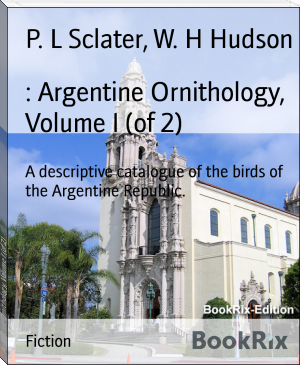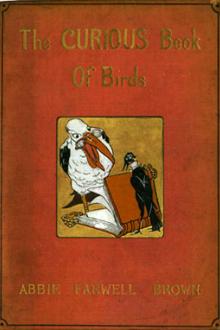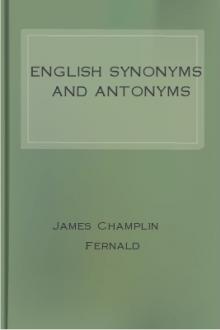: Argentine Ornithology, Volume I (of 2), P. L Sclater, W. H Hudson [best authors to read txt] 📗

- Author: P. L Sclater, W. H Hudson
Book online «: Argentine Ornithology, Volume I (of 2), P. L Sclater, W. H Hudson [best authors to read txt] 📗». Author P. L Sclater, W. H Hudson
crissum; bill black, with the base of the lower mandible yellowish;
feet black: whole length 5·5 inches, wing 3·4, tail 2·4. _Female_
similar.
_Hab._ Chili, Patagonia, Bolivia, Peru, and Western Ecuador.
Prof. Burmeister met with this species near Mendoza, in the mouths of
the large torrents above the city. Durnford found it near the river
Sengalen in Central Patagonia in December 1877.
136. CENTRITES NIGER (Bodd.). (RED-BACKED TYRANT.)
+Centrites niger+, _Burm. La-Plata Reise_, ii. p. 458; _Scl. et Salv.
Nomencl._ p. 44; _Durnford, Ibis_, 1878, p. 395 (Chupat); _White,
Z. S._ 1882, p. 604 (Buenos Ayres); _Döring, Exp. al RioNegro, Zool._ p. 42 (R. Colorado); _Barrows, Bull. Nutt. Orn.
Cl._ viii. p. 142 (Entrerios, Pampas).
_Description._--Above and below deep black: whole of back except
the rump and scapularies chestnut; bill and feet black; under
wing-coverts and wings below black: whole length 5·0 inches, wing
2·8, tail 1·9. _Female_ above brown, back fulvous red; tail black;
below ashy brown.
_Hab._ Patagonia, Chili, and Argentina.
The little Red-backed Tyrant comes nearest to _Muscisaxicola mentalis_
in habits, but does not perch on bushes and trees, and is less
gregarious than that bird. It is the smallest of all those varied
members of the _Tyrannine_ family which have abandoned forests and
marshes and the pursuit of insects on the wing, to live on the wintry
uplands of Patagonia, and on the sterile plains bordering on the Andes.
The male is only five and a quarter inches long. The entire plumage of
the male is intensely black, except the back, which is bright chestnut.
The inside of the mouth and tongue are vivid orange-yellow. The chestnut
colour on the female is pale, the rest of the plumage grey, except the
quills, which are dark.
Its summer home is in the southern portion of Patagonia, but its
nesting-habits are not known. In March it migrates north, and is very
common everywhere on the pampas throughout the winter. They arrive in
small parties of three or four, or in little loose flocks of about a
dozen individuals, travelling with a swift low flight. Males, females,
and young, grey like the last, arrive together; shortly after arriving
the young males become mottled with black, and before leaving acquire
the adult plumage. They appear to leave in spring all together, but from
a note by Durnford it would appear that the males travel in advance of
the females. He says:--"Males of this species were common at Chupat
throughout September and during the first few days of October. On the
5th of the latter month I observed the first females, which gradually
increased in number."
The Little Red-backs inhabit open unsheltered plains, and have so great
a predilection for bare ground on which they can run freely about, that
on their arrival on the pampas, where the earth is thickly carpeted with
grass, they are seen attaching themselves to roads, sheep-pens, borders
of streams, vizcacha villages, and similar places. They are exceedingly
restless, running swiftly over the ground, occasionally darting into the
air in pursuit of small flies, and all the flock so scattered that there
will be a dozen yards between every two birds. Mr. Barrows describes
their lively habits very well:--"I think this is one of the most
restless birds I ever saw. You cannot depend upon him to be in the same
place two consecutive half-seconds. He runs like a Sanderling, and
whenever he keeps his feet still by accident, his wings are flirted
in a way that shows his anxiety to be off. Several are usually found
together, and sometimes a loose flock of a hundred or more is seen. They
are very strong on the wing, sometimes mounting rapidly for several
hundred feet, if suddenly startled, and after a few moments spent in
circling like a Snipe, they drop again almost as suddenly as a shot, and
as if from the very clouds."
137. PLATYRHYNCHUS MYSTACEUS (Vieill.). (BROAD-BILLED TYRANT.)
+Platyrhynchus mystaceus+, _Scl. et Salv. Nomencl._ p. 44; _White, P.
S._ 1882, p. 605 (Misiones).
_Description._--Above olive, darker on the head; coronal patch
bright yellow; lores, eye-region, and ear-coverts pale yellowish;
mystacal stripe blackish; wings and tail blackish edged with
olive-brown; below clear fulvous, much whiter on the throat; upper
mandible blackish, lower whitish; feet pale yellowish: whole length
3·3 inches, wing 2·1, tail 1·1. _Female_ similar, but no coronal
patch.
_Hab._ Guiana, Brazil, Paraguay, and Northern La Plata.
A single example of this species was obtained by White in the forest
near San Javier, Misiones.
138. EUSCARTHMUS MARGARITACEIVENTRIS (d'Orb. et Lafr.). (PEARLY-BELLIED TYRANT.)
+Todirostrum margaritaceiventer+, _d'Orb. Voy., Ois._ p. 316
(Corrientes). +Euscarthmus margaritaceiventris+, _Scl. et Salv.
Nomencl._ p. 45; _Salvin, Ibis_, 1880, p. 357 (Tucuman). +Triccus
margaritiventris+, _Burm. La-Plata Reise_, ii. p. 456 (Paraná).
_Description._--Above olive-green, wings and tail blackish edged
with olive-green; whole head above, including sides and back of
neck, dark cinereous; beneath pearly white, passing into pale
cinereous on the sides; under wing-coverts pale yellowish, flanks
tinged with olivaceous; bill hazel; feet red: whole length 4·5
inches, wing 2·1, tail 1·9.
_Hab._ Paraguay, Northern La Plata, Bolivia, S. Peru, and S.E. Brazil.
This species, discovered by d'Orbigny in Corrientes, was also met with
near Paraná by Prof. Burmeister, and by Durnford in Tucuman.
139. EUSCARTHMUS GULARIS (Temm.). (RED-THROATED TYRANT.)
+Euscarthmus gularis+, _Scl. et Salv. Nomencl._ p. 45; _White, P. Z.
S._ 1882, p. 605 (Corrientes and Oran).
_Description._--Olive-brown; wings blackish, wing-coverts tipped and
outer secondaries edged with yellowish white, forming two distinct
bands; remiges and rectrices narrowly margined with olive; head
above dark cinereous; lores and sides of the head surrounding
the dark ear-coverts rufous; beneath white, sides of the breast
greyish; chin and sides of throat rufous, like the lores; flanks
and under wing-coverts tinged with yellowish: whole length 3·5
inches, wing 1·8, tail 1·4. _Female_ similar.
_Hab._ S.E. Brazil, Bolivia, and Northern La Plata.
This bird was observed by White near Oran, and also in Misiones.
140. PHYLLOSCARTES VENTRALIS (Temm.). (YELLOW-BELLIED TYRANT.)
+Phylloscartes ventralis+, _Scl. et Salv. Nomencl._ p. 46; _Barrows,
Bull. Nutt. Orn. Cl._ viii. p. 198 (Entrerios).
_Description._--Above uniform olive; ill-defined superciliaries
whitish; ear-coverts dark; wings and tail blackish with olive
margins; well-defined spots on the tips of the two rows of
wing-coverts and outer webs of secondaries yellowish; below yellow,
rather white on the throat and olivaceous on the sides; under
wing-coverts pale yellow; bill and feet blackish: whole length 4·5
inches, wing 2·1, tail 2·3.
_Hab._ S.E. Brazil and Northern La Plata.
This species is stated to have been met with by Mr. Barrows among the
low bushes bordering the streams of Entrerios. Graf v. Berlepsch has
recorded its presence in Rio Grande do Sul (Zeitschr. ges. Orn. 1885,
p. 131), so that this occurrence is not improbable.
141. HAPALOCERCUS FLAVIVENTRIS (d'Orb. et Lafr.). (REED-TYRANT.)
+Arundinicola flaviventris+, _d'Orb. Voy., Ois._ p. 335, pl. xxxi.
fig. 1. +Hapalocercus flaviventris+, _Burm. La-Plata Reise_, ii.
456 (Mendoza); _Scl. et Salv. Nomencl._ p. 46; _Durnford,Ibis_, 1877, p. 177 (Buenos Ayres), et 1878, p. 395 (Centr.
Patagonia); _White, P. Z. S._ 1882, p. 605 (Buenos Ayres);
_Barrows, Bull. Nutt. Orn. Cl._ viii. p. 199 (Entrerios).
_Description._--Above mouse-brown; wings and tail rather darker,
with edgings like the back; vertex more or less tinged with rufous;
beneath yellow; under wing-coverts pale yellow; bill and feet black:
whole length 4·0 inches, wing 2·0, tail 2·0. _Female_ similar.
_Hab._ S. Brazil, Paraguay, Uruguay, La Plata, and Chili.
This little bird is rarely met with in the desert pampas, but throughout
the settled portion of the Buenos-Ayrean province it is one of the
most common species of the _Tyrannidæ_. It arrives from the north in
September, and is very regular in its migrations, although apparently
a very feeble flier. It frequents open grounds abounding in thistles,
tall weeds, or bushes, and is consequently most abundant about houses.
It is extremely active, and occasionally darts after a passing insect
and captures it on the wing, especially soft insects, like moths and
butterflies, to which it





Comments (0)